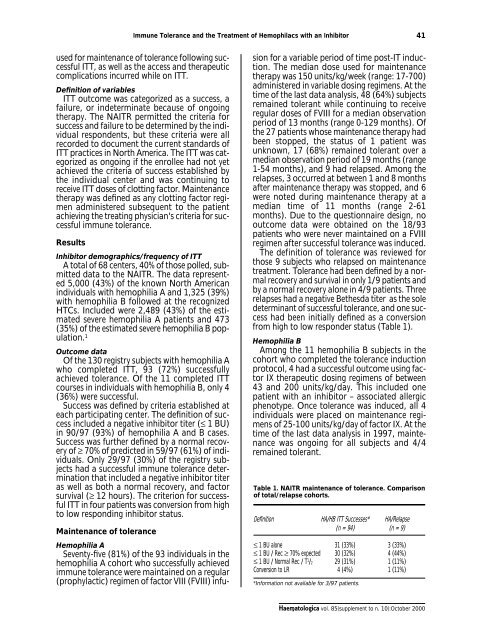Haematologica 2000;85:supplement to no. 10 - Supplements ...
Haematologica 2000;85:supplement to no. 10 - Supplements ...
Haematologica 2000;85:supplement to no. 10 - Supplements ...
Create successful ePaper yourself
Turn your PDF publications into a flip-book with our unique Google optimized e-Paper software.
Immune Tolerance and the Treatment of Hemophilacs with an Inhibi<strong>to</strong>r 41<br />
used for maintenance of <strong>to</strong>lerance following successful<br />
ITT, as well as the access and therapeutic<br />
complications incurred while on ITT.<br />
Definition of variables<br />
ITT outcome was categorized as a success, a<br />
failure, or indeterminate because of ongoing<br />
therapy. The NAITR permitted the criteria for<br />
success and failure <strong>to</strong> be determined by the individual<br />
respondents, but these criteria were all<br />
recorded <strong>to</strong> document the current standards of<br />
ITT practices in North America. The ITT was categorized<br />
as ongoing if the enrollee had <strong>no</strong>t yet<br />
achieved the criteria of success established by<br />
the individual center and was continuing <strong>to</strong><br />
receive ITT doses of clotting fac<strong>to</strong>r. Maintenance<br />
therapy was defined as any clotting fac<strong>to</strong>r regimen<br />
administered subsequent <strong>to</strong> the patient<br />
achieving the treating physician's criteria for successful<br />
immune <strong>to</strong>lerance.<br />
Results<br />
Inhibi<strong>to</strong>r demographics/frequency of ITT<br />
A <strong>to</strong>tal of 68 centers, 40% of those polled, submitted<br />
data <strong>to</strong> the NAITR. The data represented<br />
5,000 (43%) of the k<strong>no</strong>wn North American<br />
individuals with hemophilia A and 1,325 (39%)<br />
with hemophilia B followed at the recognized<br />
HTCs. Included were 2,489 (43%) of the estimated<br />
severe hemophilia A patients and 473<br />
(35%) of the estimated severe hemophilia B population.<br />
1<br />
Outcome data<br />
Of the 130 registry subjects with hemophilia A<br />
who completed ITT, 93 (72%) successfully<br />
achieved <strong>to</strong>lerance. Of the 11 completed ITT<br />
courses in individuals with hemophilia B, only 4<br />
(36%) were successful.<br />
Success was defined by criteria established at<br />
each participating center. The definition of success<br />
included a negative inhibi<strong>to</strong>r titer (≤ 1 BU)<br />
in 90/97 (93%) of hemophilia A and B cases.<br />
Success was further defined by a <strong>no</strong>rmal recovery<br />
of ≥ 70% of predicted in 59/97 (61%) of individuals.<br />
Only 29/97 (30%) of the registry subjects<br />
had a successful immune <strong>to</strong>lerance determination<br />
that included a negative inhibi<strong>to</strong>r titer<br />
as well as both a <strong>no</strong>rmal recovery, and fac<strong>to</strong>r<br />
survival (≥ 12 hours). The criterion for successful<br />
ITT in four patients was conversion from high<br />
<strong>to</strong> low responding inhibi<strong>to</strong>r status.<br />
Maintenance of <strong>to</strong>lerance<br />
Hemophilia A<br />
Seventy-five (81%) of the 93 individuals in the<br />
hemophilia A cohort who successfully achieved<br />
immune <strong>to</strong>lerance were maintained on a regular<br />
(prophylactic) regimen of fac<strong>to</strong>r VIII (FVIII) infusion<br />
for a variable period of time post-IT induction.<br />
The median dose used for maintenance<br />
therapy was 150 units/kg/week (range: 17-700)<br />
administered in variable dosing regimens. At the<br />
time of the last data analysis, 48 (64%) subjects<br />
remained <strong>to</strong>lerant while continuing <strong>to</strong> receive<br />
regular doses of FVIII for a median observation<br />
period of 13 months (range 0-129 months). Of<br />
the 27 patients whose maintenance therapy had<br />
been s<strong>to</strong>pped, the status of 1 patient was<br />
unk<strong>no</strong>wn, 17 (68%) remained <strong>to</strong>lerant over a<br />
median observation period of 19 months (range<br />
1-54 months), and 9 had relapsed. Among the<br />
relapses, 3 occurred at between 1 and 8 months<br />
after maintenance therapy was s<strong>to</strong>pped, and 6<br />
were <strong>no</strong>ted during maintenance therapy at a<br />
median time of 11 months (range 2-61<br />
months). Due <strong>to</strong> the questionnaire design, <strong>no</strong><br />
outcome data were obtained on the 18/93<br />
patients who were never maintained on a FVIII<br />
regimen after successful <strong>to</strong>lerance was induced.<br />
The definition of <strong>to</strong>lerance was reviewed for<br />
those 9 subjects who relapsed on maintenance<br />
treatment. Tolerance had been defined by a <strong>no</strong>rmal<br />
recovery and survival in only 1/9 patients and<br />
by a <strong>no</strong>rmal recovery alone in 4/9 patients. Three<br />
relapses had a negative Bethesda titer as the sole<br />
determinant of successful <strong>to</strong>lerance, and one success<br />
had been initially defined as a conversion<br />
from high <strong>to</strong> low responder status (Table 1).<br />
Hemophilia B<br />
Among the 11 hemophilia B subjects in the<br />
cohort who completed the <strong>to</strong>lerance induction<br />
pro<strong>to</strong>col, 4 had a successful outcome using fac<strong>to</strong>r<br />
IX therapeutic dosing regimens of between<br />
43 and 200 units/kg/day. This included one<br />
patient with an inhibi<strong>to</strong>r – associated allergic<br />
phe<strong>no</strong>type. Once <strong>to</strong>lerance was induced, all 4<br />
individuals were placed on maintenance regimens<br />
of 25-<strong>10</strong>0 units/kg/day of fac<strong>to</strong>r IX. At the<br />
time of the last data analysis in 1997, maintenance<br />
was ongoing for all subjects and 4/4<br />
remained <strong>to</strong>lerant.<br />
Table 1. NAITR maintenance of <strong>to</strong>lerance. Comparison<br />
of <strong>to</strong>tal/relapse cohorts.<br />
Definition HA/HB ITT Successes* HA/Relapse<br />
(n = 94) (n = 9)<br />
≤ 1 BU alone 31 (33%) 3 (33%)<br />
≤ 1 BU / Rec ≥ 70% expected 30 (32%) 4 (44%)<br />
≤ 1 BU / Normal Rec / T 1 /2 29 (31%) 1 (11%)<br />
Conversion <strong>to</strong> LR 4 (4%) 1 (11%)<br />
*Information <strong>no</strong>t available for 3/97 patients.<br />
<strong>Haema<strong>to</strong>logica</strong> vol. <strong>85</strong>(<strong>supplement</strong> <strong>to</strong> n. <strong>10</strong>):Oc<strong>to</strong>ber <strong>2000</strong>
















